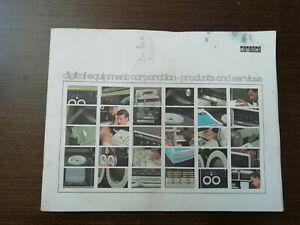Cover chariot
Liste des meilleures ventes cover chariot

France (Toutes les villes)
digital equipement corporation - products and services circa 1960/1970 très beau document publicitaire pour DEC datant probablement de la fin des années 60, sans date. avec les produits PDP 8i, PDP 8L, PDP 12, PDP 15, PDP 10, PDP 14, peripherals, DEC supplies, manufacturing very interesting leaflet of DEC probably from the end of the 60's, not dated. with the products PDP 8i, PDP 8L, PDP 12, PDP 15, PDP 10, PDP 14, peripherals, DEC supplies, manufacturing Nombreuses photos des ordinateurs disponibles, de periphériques et de l'usine / numerous photos of available computers, peripherals and the factory dimensions: 28 x 21,5 cm - 20 pages - 011. 00969. AIE S. 02. 50 rare document - assez bon état - couverture un peu tachée, intérieur propre / good condition, cover with stains, inside is perfect N 'hésitez pas à poser des questions si vous avez besoin de plus de détails. Remise en mains propres sur Paris 8ème - secteur Europe - Pour des achats groupés, les frais d'envois seront ajustés For bidders from foreign countries, don't hesitate to ask for the postage price, I'll give you the exact price. English, spanish, japanese and chinese language = OK Au sujet de cette marque / about DEC, (source wikipedia): Digital Equipment Corporation (DEC /dɛk/), using the trademark Digital, was a major American company in the computer industry from the 1960s to the 1990s. The company was co-founded by Ken Olsen and Harlan Anderson in 1957. Olsen was president until forced to resign in 1992, after the company had gone into precipitous decline. Although the company produced many different product lines over their history, they are best known for their work in the minicomputer market starting in the mid-1960s. The company produced a series of machines known as the PDP line, with the PDP-8 and PDP-11 being among the most successful minis of all time. Their success was only surpassed by another DEC product, the late-1970s VAX "supermini" systems that were designed to replace the PDP-11. Although a number of competitors had successfully competed with Digital through the 1970s, the VAX cemented the company's place as a leading vendor in the computer space. As microcomputers improved in the late 1980s, especially with the introduction of RISC-based workstation machines, the performance niche of the minicomputer was rapidly eroded. By the early 1990s, the company was in turmoil as their mini sales collapsed and their attempts to address this by entering the high-end market with machines like the VAX 9000 were market failures. After several attempts to enter the workstation and file server market, the DEC Alpha product line began to make successful inroads in the mid-1990s, but was too late to save the company. DEC was acquired in June 1998 by Compaq in what was at that time the largest merger in the history of the computer industry. During the purchase, some parts of DEC were sold to other companies; the compiler business and the Hudson, Massachusetts facility, were sold to Intel. At the time, Compaq was focused on the enterprise market and had recently purchased several other large vendors. DEC was a major player overseas where Compaq had less presence. However, Compaq had little idea what to do with its acquisitions, and soon found itself in financial difficulty of its own. The company subsequently merged with Hewlett-Packard (HP) in May 2002. La société a été fondée en 1957 par Ken Olsen, un ingénieur du Massachusetts qui avait travaillé sur le projet TX-2 au laboratoire Lincoln du Massachusetts Institute of Technology (MIT). Le TX-2 était un ordinateur basé sur des transistors. Lorsque ce projet rencontra des difficultés, Olsen le quitta pour fonder DEC avec Harlan Anderson (en), un collègue du MIT. À cette époque les investisseurs n'étaient pas favorables aux sociétés informatiques. Ils commencèrent donc par construire des petits modules numériques (correspondant aux composants du TX-2) pouvant être combinés pour être utilisés dans un laboratoire. En 1961 la société était bénéficiaire et commença la construction de son premier ordinateur: le PDP-1. Durant les années 1960 DEC produit une série d'ordinateurs ayant un meilleur rapport prix/performances que ceux d'IBM, généralement basés sur des mots de 18 bits. Le succès arriva en 1964 avec le PDP-8. Il s'agissait d'un ordinateur 12 bits vendu environ 16 000 $. Le PDP-8 était assez petit pour tenir sur un chariot. Il était assez simple d'usage pour de nombreuses applications et conquit de nombreux marchés de niche, laboratoires, chemins de fer et applications industrielles. Le PDP-8 est aujourd'hui considéré comme le premier mini-ordinateur. Le dernier ordinateur marquant de la série PDP est le PDP-11. Il utilisait des mots de 16 bits pour supporter les caractères ASCII devenus standards. Il avait 64 kilooctets de RAM. Il est notamment connu pour avoir été l'ordinateur sur lequel UNIX et le langage C ont été développés. En 1976, DEC conçut une nouvelle architecture 32 bits et joue un rôle capital dans le lancement d'une course aux machines moins coûteuses, plus maniables et plus puissantes, face au monopole IBM. Elle fut introduite en 1978 par le VAX 11/780 et s'empara rapidement du marché des mini-ordinateurs. Les VAX pouvaient être utilisés avec le système d'exploitation UNIX ou VMS de DEC. Le succès commercial de DEC culmina vers la fin des années 1980. C'était le second plus grand constructeur d'ordinateurs et comptait 100 000 employés. À ce moment DEC proposait de nombreux produits propriétaires comme le réseau DECnet. Comme ces produits n'étaient conçus pour fonctionner qu'avec des produits DEC, les consommateurs se tournèrent vers des produits plus standards. Au même moment les performances des stations de travail RISC rejoignaient celles des VAX. Malheureusement Ken Olsen ne crut pas en l'avenir de l'informatique individuelle et Digital manqua le virage du PC.
56 €
Voir le product
